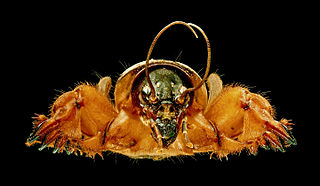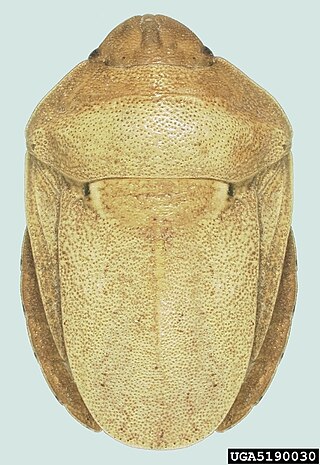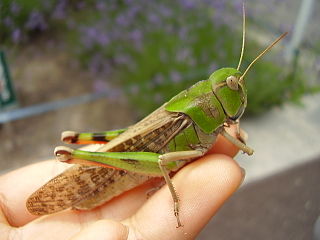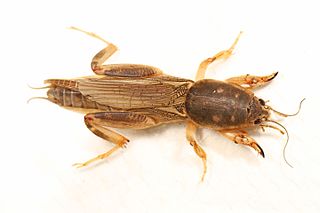
Moles are small mammals adapted to a subterranean lifestyle. They have cylindrical bodies, velvety fur, very small, inconspicuous eyes and ears, reduced hindlimbs, and short, powerful forelimbs with large paws adapted for digging.

Mole crickets are members of the insect family Gryllotalpidae, in the order Orthoptera. Mole crickets are cylindrical-bodied, fossorial insects about 3–5 cm (1.2–2.0 in) long as adults, with small eyes and shovel-like fore limbs highly developed for burrowing. They are present in many parts of the world and where they have arrived in new regions, may become agricultural pests.

The giant blind mole-rat is a species of rodent in the family Spalacidae endemic to the North Caucasus region of Russia. It feeds on roots and tubers and lives underground in a burrow that it digs with its teeth.
Gryllotalpa major,also known as the Prairie Mole Cricket, is endemic to the United States and is the largest cricket in North America. Its natural habitat is temperate grassland and it belongs to the family Gryllotalpidae. It is threatened by habitat loss, and is currently only found in Oklahoma, Kansas, Missouri, Nebraska and Arkansas. Males of this species produce sounds by rubbing their fore wings together. They sing from special burrows they construct in the prairie soil to attract females for mating, and they can be heard at distances up to 400 m from the burrow. Males aggregate their acoustic burrows in a lek arena and are very sensitive to vibrations carried through the ground. Males communicate with neighboring males through vibrational signals, and the songs they project to flying females are harmonic chirps, rather than the trills produced by most mole crickets.

Gryllotalpa gryllotalpa, commonly known as the European mole cricket, is widespread in Europe and has been introduced to the eastern United States. The scientific name is derived from the Latin 'gryllus' meaning a cricket and 'talpa', a mole, and is descriptive because of the fine dense fur by which it is covered and its subterranean habits, and because of the mole-like forelegs adapted for digging, a good example of convergent evolution.

Larra, also known as mole cricket wasps or mole cricket hunters, is a genus of wasps that prey on various species of mole crickets. They have gained prominence as integrated pest management agents.

Larra bicolor is a parasitoid wasp native to South America. It was introduced into Florida as a biological pest control of invasive mole crickets.

Eurygaster integriceps is a species of shield bug in the family Scutelleridae, commonly known as the sunn pest or corn bug. It is native to much of northern Africa, the Balkans and western and central Asia. It is a major pest of cereal crops especially wheat, barley and oats.

Dociostaurus maroccanus, commonly known as the Moroccan locust, is a grasshopper in the insect family Acrididae. It is found in northern Africa, southern and eastern Europe and western Asia. It lives a solitary existence but in some years its numbers increase sharply, and it becomes gregarious and congregates to form swarms which can cause devastation in agricultural areas. The species was first described by Carl Peter Thunberg in 1815.

Scapteriscus is a genus of insects in the family Gryllotalpidae, the mole crickets. Members of the genus are called two-clawed mole crickets. They are native to South America. Some species have arrived in other regions, including parts of North America, where some have become invasive and have become established as pests.

The Turkestan cockroach, also known as the rusty red cockroach, red runner cockroach or simply rusty red, red runner, or lat, is a primarily outdoor-dwelling cockroach native to an area from northern Africa to Central Asia. Adults measure around 3 cm (1.2 in) in length. Adult males are a brownish orange or red, are slender, and have long, yellowish wings which allow it to attract females and to glide. Adult females are dark brown to black, with cream-colored markings on the shield and a cream-colored stripe edging its wings; they are broader than males, and have short vestigial wings. Nymphs are brown in front, black on the rear, and are wingless.

Gryllotalpa africana, also known as the African mole cricket, is a relatively small mole cricket species, native to Africa, but local populations exist in Asia, and southern Europe.
Mango mealybug, is a pest of mango crops in Asia. The nymphs and females suck plant sap from inflorescences, tender leaves, shoots and fruit peduncles. As a result, the infested inflorescences dry up, affects the fruit set, causing fruit drop. These bugs also exude honey dew over the mango tree leaves, on which sooty mold fungus develops reducing the photosynthetic efficiency of the tree. It is a polyphagous pest and is found on over 60 other plant species

Locusta migratoria manilensis, commonly known as the Oriental migratory locust, is a subspecies of the migratory locust in the family Acrididae. It is sufficiently different in size and structure from the African migratory locust to be considered a distinct subspecies of the migratory locust. It is found in southeastern Asia and is an important agricultural pest in the region. It is normally a solitary insect but when conditions are suitable, it enters into a gregarious phase when the young form into bands which move together and the adults into swarms. Although outbreaks may have recently been fewer in number and size because of changes in agricultural practices and better locust detection, the insects remain active as crop pests and the potential for outbreaks is still present.
Ormia depleta, sometimes called the Brazilian red-eyed fly, is a species of fly in the family Tachinidae. It is a parasitoid of mole crickets in the genus Scapteriscus. It is native to South America but has been imported into the United States and elsewhere as a biological pest control agent.

Neoscapteriscus vicinus, the tawny mole cricket, is a species of insect in the mole cricket family, Gryllotalpidae. This species is native to South America and also occurs in the Southern United States, where it arrived as a contaminant of ship's ballast around 1900. Colombian insect taxonomist Oscar Cadena-Castañeda studied specimens of the genus which had been called Scapteriscus, and decided that it included two groups; a smaller group and a larger group that he named Neoscapteriscus in 2015. North American mole cricket taxonomists agreed with his decision and altered Orthoptera Species File Online accordingly.

Scapteriscus borellii, the southern mole cricket, is a species of insect in the family Gryllotalpidae. It is native to South America but is also present in the southern United States where it was introduced around 1900.

Brachytrupes membranaceus, the tobacco cricket, is a species of cricket in the family Gryllidae. It is a pest of crops including young tobacco plants. There are four subspecies, all of which are native to Africa.

Larra anathema is a species of parasitoid wasps belonging to the family Crabronidae. It is the type species of the genus Larra.

Dysdercus koenigii is a species of true bug in the family Pyrrhocoridae, commonly known as the red cotton stainer. It is a serious pest of cotton crops, the adults and older nymphs feeding on the emerging bolls and the cotton seeds as they mature, transmitting cotton staining fungi as they do so.















